jupiter
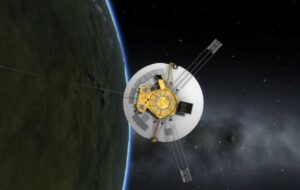
 Many of us have seen shows about a spacecraft that got lost in space and is seen wandering around trying to make their way back. Of course, those shows are fiction, but if you were going to explore beyond our galaxy, you would most likely need to send some sort of probe or spaceship out into the far reaches of space to see what it’s like out there. If the empty probe can’t function out there, it’s very likely not a good idea to send a manned spaceship out there. That is what Nasa figured anyway, and so in 1972, Pioneer 10…originally designated Pioneer F, was launched into space. Pioneer 10 is an American space probe, manufactured by TRW Inc. It isn’t overly heavy, weighing just 569 pounds. Its first mission to the planet Jupiter was completed with its closest approach happening on Dec 3, 1973. At that point, Pioneer 10 became the first of five artificial objects to achieve the escape velocity needed to leave the Solar System. At that point, it became part of a space exploration project that was conducted by the NASA Ames Research Center in California.
Many of us have seen shows about a spacecraft that got lost in space and is seen wandering around trying to make their way back. Of course, those shows are fiction, but if you were going to explore beyond our galaxy, you would most likely need to send some sort of probe or spaceship out into the far reaches of space to see what it’s like out there. If the empty probe can’t function out there, it’s very likely not a good idea to send a manned spaceship out there. That is what Nasa figured anyway, and so in 1972, Pioneer 10…originally designated Pioneer F, was launched into space. Pioneer 10 is an American space probe, manufactured by TRW Inc. It isn’t overly heavy, weighing just 569 pounds. Its first mission to the planet Jupiter was completed with its closest approach happening on Dec 3, 1973. At that point, Pioneer 10 became the first of five artificial objects to achieve the escape velocity needed to leave the Solar System. At that point, it became part of a space exploration project that was conducted by the NASA Ames Research Center in California.
“Pioneer 10 was assembled around a hexagonal bus with a 9-foot diameter parabolic dish high-gain antenna, and the spacecraft was spin stabilized around the axis of the antenna. Its electric power was supplied by four radioisotope thermoelectric generators that provided a combined 155 watts at launch. Pioneer was launched on March 2, 1972, by an Atlas-Centaur expendable vehicle from Cape Canaveral, Florida. Between July 15, 1972, and February 15, 1973, it became the first spacecraft to traverse the asteroid belt. Photography of Jupiter began November 6, 1973, at a range of 16,000,000 miles, and about 500 images were transmitted. The closest approach to the planet was on December 4, 1973, at a range of 82,178 miles. During the mission, the on-board instruments were used to study the asteroid belt, the environment around Jupiter, the solar wind, cosmic rays, and eventually the far reaches of the Solar System and heliosphere.”
I find it hard to believe that Nasa thought that the spacecraft would last as long as it did, but I suppose that the further out it went in space, the less it would encounter the kind of space debris that came from Earth. Still, there are meteors and planets, stars that it could be pulled into, and so many more things that could have meant the destruction if the craft. Nevertheless, Pioneer 10 continued to send out radio transmissions continued between Nasa and itself until January 23, 2003, and then only because of the loss of electric power for its radio transmitter. At that point, the probe was at a distance of 12 billion kilometers (7,456,454,306.848 miles) from Earth. 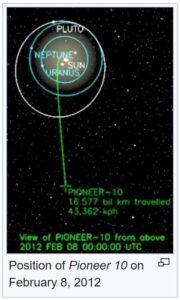
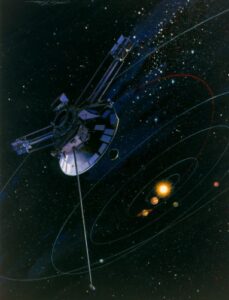
According to sources, “If left undisturbed, Pioneer 10 and its sister craft Pioneer 11 will join the two Voyager spacecraft and the New Horizons spacecraft in leaving the Solar System to wander the interstellar medium. The Pioneer 10 trajectory is expected to take it in the general direction of the star Aldebaran, currently located at a distance of about 68 light years. If Aldebaran had zero relative velocity, it would require more than two million years for the spacecraft to reach it. Well before that, in about 90,000 years, Pioneer 10 will pass about 0.23 parsecs (0.75 light-years) from the late K-type star HIP 117795. This is the closest stellar flyby in the next few million years of all the four Pioneer and Voyager spacecrafts, which are leaving the Solar System.”
 In 1912, the coal transport ship, Jupiter, was transformed, into the US Navy’s first aircraft carrier. The ship was recommissioned USS Langley (CV-1) and was the first aircraft carrier in history. As aircraft carriers go, we would have laughed about the look of this one. This recreated coal transport ship probably should have just stayed a coal transport, but then we wouldn’t have the aircraft carriers we have today, if Jupiter had not been transformed. It all had to start somewhere.
In 1912, the coal transport ship, Jupiter, was transformed, into the US Navy’s first aircraft carrier. The ship was recommissioned USS Langley (CV-1) and was the first aircraft carrier in history. As aircraft carriers go, we would have laughed about the look of this one. This recreated coal transport ship probably should have just stayed a coal transport, but then we wouldn’t have the aircraft carriers we have today, if Jupiter had not been transformed. It all had to start somewhere.
While USS Langley was the first aircraft carrier made, it was not the first to go down in battle. That “honor” goes to HMS Courageous, on September 17, 1939, only a couple weeks after World War II in Europe began. On that day, German U-boat, U-29, sunk the British aircraft carrier with 2 of the 3 torpedoes fired striking the unfortunate carrier. Courageous went down, taking 519 of her crew with her, thereby becoming the first aircraft carrier ever sunk by a submarine. The US Navy’s first aircraft carrier, the Langley, managed to survive until February 27, 1942, when it was sunk by Japanese warplanes (with a little help from US destroyers), and all of its 32 aircraft are lost.
The USS Langley was originally launched in 1912 as the naval collier (coal transport ship) Jupiter. After World 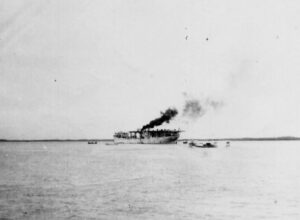 War I, the Jupiter was converted into the Navy’s first aircraft carrier and rechristened the Langley, after aviation pioneer Samuel Pierpont Langley. Uss Langley was the Navy’s first electrically propelled ship. It was capable of speeds of 15 knots. On October 17, 1922, Lieutenant Virgil C Griffin had the great honor of piloting the first plane, a VE-7-SF, from Langley’s decks. Planes had taken off from ships before, but this was a historic moment. The prestige was short-lived, and after 1937, the Langley lost the forward 40 percent of her flight deck as part of a conversion to seaplane tender, a mobile base for squadrons of patrol bombers.
War I, the Jupiter was converted into the Navy’s first aircraft carrier and rechristened the Langley, after aviation pioneer Samuel Pierpont Langley. Uss Langley was the Navy’s first electrically propelled ship. It was capable of speeds of 15 knots. On October 17, 1922, Lieutenant Virgil C Griffin had the great honor of piloting the first plane, a VE-7-SF, from Langley’s decks. Planes had taken off from ships before, but this was a historic moment. The prestige was short-lived, and after 1937, the Langley lost the forward 40 percent of her flight deck as part of a conversion to seaplane tender, a mobile base for squadrons of patrol bombers.
The Langley was part of the Asiatic Fleet in the Philippines when the Japanese attacked on December 8, 1941. Immediately setting sail for Australia, she arrived on January 1, 1942. On February 22nd, under the command of Robert P McConnell, the Langley, carrying 32 Warhawk fighters, left as part of a convoy to aid the Allies in their battle against the Japanese in the Dutch East Indies. Then, on February 27, the Langley parted company 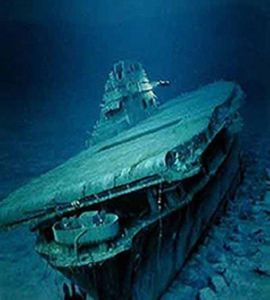 from the convoy and headed straight for the port at Tjilatjap, Java. About 74 miles south of Java, the carrier met up with two US escort destroyers. Then nine Japanese twin-engine bombers attacked the ship. Although the Langley had requested a fighter escort from Java for cover, none could be spared. She and the escort destroyers were virtually alone. The first two Japanese bomber runs missed their target, as they were flying too high, but the third time around they hit their mark three times. The planes on deck went up in flames. The carrier began to list, and Commander McConnell lost his ability to navigate the ship. In an effort to save his men, McConnell ordered the Langley abandoned, and the escort destroyers were able to take his crew to safety. Of the 300 crewmen, only 16 were lost. The destroyers then sank the Langley before the Japanese were able to capture it. It was necessary that they keep it out of Japanese hands. Better at the bottom of the sea that in the hands of the Japanese.
from the convoy and headed straight for the port at Tjilatjap, Java. About 74 miles south of Java, the carrier met up with two US escort destroyers. Then nine Japanese twin-engine bombers attacked the ship. Although the Langley had requested a fighter escort from Java for cover, none could be spared. She and the escort destroyers were virtually alone. The first two Japanese bomber runs missed their target, as they were flying too high, but the third time around they hit their mark three times. The planes on deck went up in flames. The carrier began to list, and Commander McConnell lost his ability to navigate the ship. In an effort to save his men, McConnell ordered the Langley abandoned, and the escort destroyers were able to take his crew to safety. Of the 300 crewmen, only 16 were lost. The destroyers then sank the Langley before the Japanese were able to capture it. It was necessary that they keep it out of Japanese hands. Better at the bottom of the sea that in the hands of the Japanese.

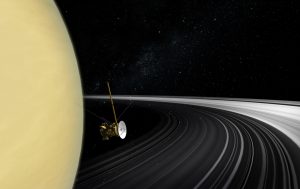 When we think of space exploration, I think most of us think about the moon or the International Space Station, but NASA has really done more exploring of other areas that it has of the moon. One such mission was NASA’s Cassini spacecraft, and the Huygens probe. Cassini launched in 1997, along with ESA’s Huygens probe. It was a joint endeavor of NASA, the European Space Agency, or ESA, and the Italian Space Agency. For six months in 2000, the spacecraft contributed to studies of Jupiter, before continuing on to its destination…Saturn, on June 30, 2004 and starting a string of flybys of Saturn’s moons. The Huygens probe was released later that year on Saturn’s moon Titan to conduct a study of the moon’s atmosphere and surface composition. In its second extended mission, Cassini made the first observations of a complete seasonal period for Saturn and its moons, flew between the rings and descended into the planet’s atmosphere.
When we think of space exploration, I think most of us think about the moon or the International Space Station, but NASA has really done more exploring of other areas that it has of the moon. One such mission was NASA’s Cassini spacecraft, and the Huygens probe. Cassini launched in 1997, along with ESA’s Huygens probe. It was a joint endeavor of NASA, the European Space Agency, or ESA, and the Italian Space Agency. For six months in 2000, the spacecraft contributed to studies of Jupiter, before continuing on to its destination…Saturn, on June 30, 2004 and starting a string of flybys of Saturn’s moons. The Huygens probe was released later that year on Saturn’s moon Titan to conduct a study of the moon’s atmosphere and surface composition. In its second extended mission, Cassini made the first observations of a complete seasonal period for Saturn and its moons, flew between the rings and descended into the planet’s atmosphere.
Upon arrival at Saturn, Cassini-Huygens began its mission by doing several flybys of Saturn’s moons. Saturn has at least 150 moons and moonlets in total, though only 62 have confirmed orbits and only 53 have been given official names. Every year, it seems, more moons are discovered. Most of the moons are small, icy bodies that probably broke off of Saturn’s impressive ring system. In fact, 34 of the moons that have been named are less than 7 miles in diameter while another 14 are 7 to 31 miles in diameter. However, some of its inner and outer moons are among the largest and most dramatic in the Solar System, measuring between 155 and 3106 miles in diameter and housing some of greatest mysteries in the Solar System. These moons aren’t all round, but rather have taken on several unusual and interesting shapes.
The rings of Saturn posed a particular problem if the Cassini was fly through them and descend into Saturn’s atmosphere. The rings of Saturn are the most extensive ring system of any planet in the Solar System. They consist of countless small particles, ranging in size from micrometers to meters, that orbit about Saturn. The ring particles are made almost entirely of water ice, with a trace component of rocky material. No one really 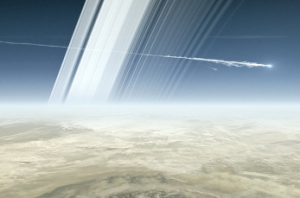
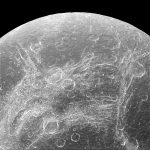 understands exactly how the rings are formed. Although theoretical models indicated that the rings were likely to have formed early in the Solar System’s history, new data from Cassini suggest they formed relatively late. That and several other things about Saturn are the reasons for its exploration. On September 15, 2017, twenty years after the Cassini-Huygens mission began, it was over, and Cassini began its Final Entry into Saturn’s Atmosphere…breaking up as it broke through.
understands exactly how the rings are formed. Although theoretical models indicated that the rings were likely to have formed early in the Solar System’s history, new data from Cassini suggest they formed relatively late. That and several other things about Saturn are the reasons for its exploration. On September 15, 2017, twenty years after the Cassini-Huygens mission began, it was over, and Cassini began its Final Entry into Saturn’s Atmosphere…breaking up as it broke through.

